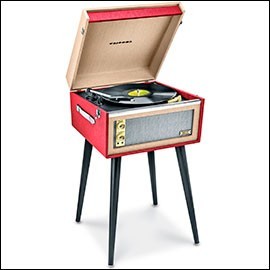Antique Record Players
Antique record players are the logical evolution of gramophones. The basic concept of operation is the same for both devices: the needle placed on the arm comes into contact with a rotating disc, and then conducts the sound generated through a speaker for broadcasting. Record players differ from gramophones in two fundamental aspects: they work ...
Antique record players are the logical evolution of gramophones. The basic concept of operation is the same for both devices: the needle placed on the arm comes into contact with a rotating disc, and then conducts the sound generated through a speaker for broadcasting. Record players differ from gramophones in two fundamental aspects: they work with vinyl records (instead of the old slate records) and the platter rotates by means of an electric motor, much more comfortable and functional than the crank motor of gramophones. The first antique turntables date back to 1930; in our collections we have models from that era, but also gorgeous retro designs from the 1960s and 1970s, as well as attractive vintage turntables from the 1980s.
History of vintage record players.
With the popularization of the gramophone, the recording industry continued to research in search of more reliable and functional systems, which also provided better sound quality. Thus, in 1925 the first electric record players appeared; this evolution was made possible by the development of tube amplifiers and sound pick-up arms (known as pick-ups, a name that was later also applied to the turntables themselves).
The advantages of these devices over the cumbersome gramophones were obvious:
- The electric motor allowed the discs to be spun at different speeds, always constant, thus improving the sound,
- The pickup arms weighed significantly less, which generated less disc wear.
- Vinyl records were lighter, cheaper and stronger than slate records.
A few years later, the appearance of semi-automatic record players added a new advantage: at the end of record playback the arm would lift and move back to its initial position, automatically turning the device off. Systems were also developed that allowed several discs to be placed on top of each other on the platter, so that they could be played consecutively. This made it possible to enjoy the music for much longer, without having to turn over or change the disc.
Vintage record players: iconic models.
Over several decades, record players evolved in search of better performance and a more compact and attractive design. The earliest early turntables could only play records at two speeds: 77.8 and 78.2 RPM. However, in the 1940s the firm RCA launched two new models, the 9EY3 and the9EY3M, which included a new speed: 45 RPM. During the 70s, magnificent designs were made that still arouse our admiration today: turntables with plastic material casing, devices with wooden body and methacrylate cover, suitcase-type models (portable, with the speakers on the sides)... Among them stand out emblematic turntables such as the Philips 22 GF Portable, a compact, comfortable and quality device, fundamental in the boom that music experienced in the 70s of the twentieth century. The TD150 and TD160 models, manufactured by Thorens in the 60s and 70s, are also legendary designs that combine elegance and good sound. Another model to note is the Schneider SSS turntable: its orange plastic casing, stereo speakers and compact design prompted its inclusion in the L' Utopie du Tout Plastic - 1960-1973 guide, considered the "bible" of plastic design at the time.
Antique record players keep their power of fascination intact. They are highly decorative items, perfect for decorating trendy living rooms and stylish environments. In addition, their evocative sound makes them unique and exclusive pieces.
New products
-

Antique ivory and silver plated stethoscope, late 19th century
Antique stethoscope from the late 19th century in silver-plated metal...
-

Vintage pendant with shell cameo of Jesús del Gran Poder, carved c. 1970
Vintage pendant with a shell-carved cameo of Jesus del Gran Poder, circa...
-

Antique Roman Style Gilded Silver Chalice with Paten. France, 1932
Antique Roman-style chalice in gilded silver with paten. France, 1932....
-

Beautiful Antique 18 K Gold Ring with 7 Natural Diamonds
Antique 18K gold ring with 7 natural diamonds. Delicate openwork design,...
-

Antique Silver Reliquary. José Vilaplana. Valencia, Spain. Circa 1920
Impressive repoussé silver reliquary by José Vilaplana, Valencia, c....
-

Vintage 18K Gold Ring with 7 Natural Diamonds
Vintage 18K gold ring with seven natural diamonds in floral setting....
-

Antique Silver Chalice. Enameled Crosses. Valencia, Spain, 1942
Spanish chalice from 1942 in solid silver, gifted by the Church of...
-

Antique Silver Chalice and Paten. Granada Spain, circa 1900
Spanish chalice in white silver with matching paten, handcrafted....
Specials
-

Striking Antique Charlet & Cie Mantel Clock. Ormolu. France, Circa 1900
Awesome ormolu and marble mantel...

